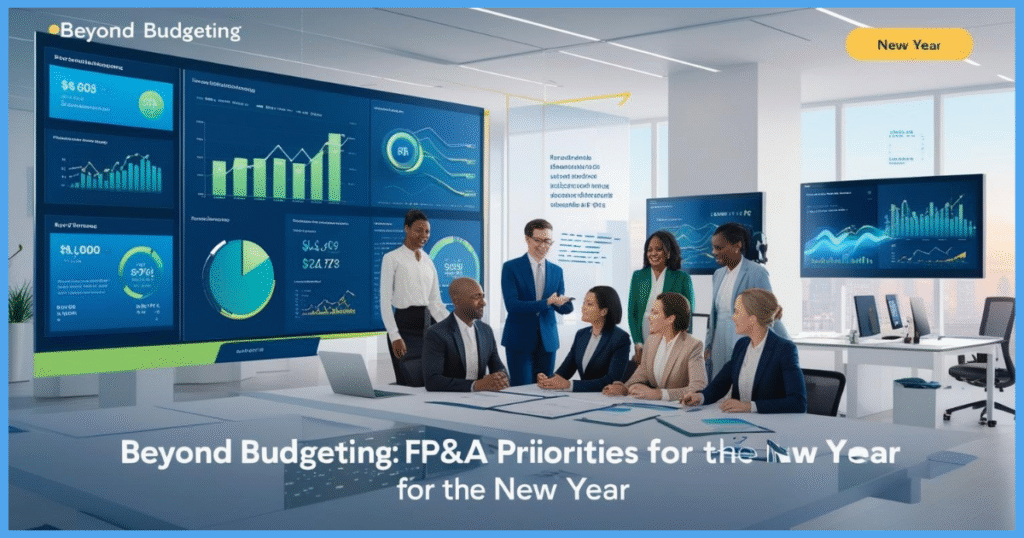The calendar has flipped, the echoes of past year’s successes and challenges still resonate, and a fresh expanse of opportunity stretches before us. For Financial Planning & Analysis (FP&A) professionals, this transition isn’t just about updating spreadsheets with new dates; it’s a pivotal moment to re-evaluate strategies, refine processes, and align priorities with the evolving business landscape. The traditional annual budgeting cycle, often a laborious and sometimes restrictive exercise, is increasingly recognized as insufficient in today’s dynamic and unpredictable environment. Therefore, as we step into this new year, it’s time to look beyond budgeting and focus on a more agile, insightful, and value-driven approach to FP&A.
This blog post will delve into the critical priorities that FP&A teams should embrace in the coming year to move beyond the limitations of traditional budgeting and become true strategic partners to the business. We will explore the key shifts in focus, the adoption of new technologies, and the essential skills required to navigate the complexities and uncertainties that lie ahead.
1. Embracing Agility and Continuous Forecasting in FP&A:
The static nature of annual budgets often renders them obsolete within months, if not weeks, in today’s rapidly changing markets. Unforeseen events, disruptive technologies, and evolving customer demands can quickly derail even the most meticulously crafted plans. Therefore, a paramount priority for FP&A teams is to move towards more agile and continuous forecasting methodologies.
1.1. Rolling Forecasts:
Implementing rolling forecasts, which involve regularly updating forecasts (e.g., monthly or quarterly) by adding a new period and dropping the oldest, provides a much more dynamic and relevant view of the future. This allows businesses to proactively identify potential risks and opportunities, adjust strategies in a timely manner, and make more informed decisions. For example, instead of relying on a budget set in December for the entire following year, a rolling 18-month forecast updated quarterly provides a constantly refreshed outlook, incorporating the latest performance data and market trends.
1.2. Scenario Planning:
The past few years have starkly highlighted the importance of preparing for multiple potential futures. FP&A teams should prioritize developing robust scenario planning capabilities. This involves identifying key uncertainties (e.g., economic downturn, competitor actions, regulatory changes) and building financial models that simulate the potential impact of different scenarios. By understanding the range of possible outcomes, businesses can develop contingency plans and make more resilient strategic choices. For instance, a retailer might develop scenarios for a surge in online sales versus a return to primarily in-store shopping, allowing them to adjust inventory and resource allocation accordingly.
1.3. Driver-Based Planning:
Shifting the focus from line-item budgeting to driver-based planning enhances agility and provides deeper insights. This approach involves identifying the key operational and market drivers that influence financial performance (e.g., sales volume, customer acquisition cost, production efficiency) and building financial models based on these drivers. When underlying drivers change, the financial forecasts automatically adjust, providing a more dynamic and responsive view than static budget figures. For a software-as-a-service (SaaS) company, key drivers might include the number of new subscribers, churn rate, and average revenue per user. Tracking and forecasting these drivers provides a more granular and actionable understanding of revenue trends.
2. Elevating Business Partnering and Collaboration for FP&A Success:
FP&A’s role is evolving from that of mere scorekeepers to strategic business partners. This requires a significant shift in mindset and approach, emphasizing collaboration, communication, and a deep understanding of the operational aspects of the business.
2.1. Proactive Engagement:
FP&A professionals should proactively engage with business units, moving beyond simply providing historical reports and instead offering forward-looking insights and recommendations. This involves actively participating in business reviews, understanding departmental strategies, and identifying opportunities for financial optimization and value creation. For example, an FP&A analyst embedded within the marketing team can provide insights into the ROI of different campaigns and help optimize marketing spend.
2.2. Clear and Concise Communication:
The ability to translate complex financial data into clear, concise, and actionable insights for non-financial stakeholders is crucial. FP&A teams should focus on developing strong communication skills, utilizing data visualization techniques, and tailoring their message to the specific audience. Instead of presenting pages of raw data, a well-designed dashboard highlighting key performance indicators (KPIs) and trends with clear narratives will be far more impactful for operational managers.
2.3. Understanding Business Drivers:
To be effective business partners, FP&A professionals need a deep understanding of the underlying business drivers and operational processes. This requires spending time with operational teams, understanding their challenges and opportunities, and aligning financial analysis with business realities. For instance, an FP&A analyst working with the supply chain team should understand the intricacies of procurement, logistics, and inventory management to provide relevant financial insights and support cost optimization efforts.

3. Leveraging Technology and Automation:
Technology plays a pivotal role in enabling FP&A teams to move beyond manual, time-consuming tasks and focus on higher-value activities. Embracing automation and leveraging sophisticated FP&A tools is no longer a luxury but a necessity for staying competitive and efficient.
3.1. Robotic Process Automation (RPA):
Implementing RPA for routine and repetitive tasks such as data collection, data entry, and report generation can significantly improve efficiency and accuracy, freeing up FP&A professionals to focus on analysis and strategic thinking. For example, RPA bots can automate the process of pulling data from various source systems, consolidating it, and preparing standard reports, reducing the time spent on these manual activities.
3.2. Advanced Planning and Analytics Platforms:
Modern FP&A platforms offer a wide range of capabilities, including sophisticated modeling, scenario planning, forecasting, and reporting tools. Investing in and effectively utilizing these platforms can significantly enhance the speed, accuracy, and sophistication of FP&A processes. These platforms often integrate with other enterprise systems, providing a holistic view of financial and operational data.
3.3. Artificial Intelligence (AI) and Machine Learning (ML):
AI and ML are increasingly being integrated into FP&A tools, offering powerful capabilities for predictive analytics, anomaly detection, and automated insights generation. For instance, ML algorithms can analyze historical data to identify patterns and predict future revenue trends with greater accuracy than traditional forecasting methods. AI-powered tools can also flag unusual transactions or variances, helping to identify potential risks or opportunities.
4. Enhancing Data Quality and Governance:
The effectiveness of any FP&A process hinges on the quality and reliability of the underlying data. Prioritizing data quality and establishing robust data governance frameworks are essential for generating accurate insights and making sound decisions.
4.1. Data Integration and Standardization:
FP&A teams often grapple with data residing in disparate systems with inconsistent formats. Implementing robust data integration processes and establishing data standards across the organization are crucial for creating a single source of truth and ensuring data consistency. This might involve investing in data warehouses or data lakes and implementing data governance policies.
4.2. Data Validation and Reconciliation:
Implementing automated data validation and reconciliation processes helps to identify and correct data errors, ensuring the accuracy and integrity of financial information. Regular reconciliation between different systems and data sources is essential for building trust in the data.
4.3. Data Security and Privacy:
With increasing regulatory scrutiny and the growing importance of data privacy, FP&A teams must prioritize data security and ensure compliance with relevant regulations. This includes implementing appropriate access controls, data encryption, and audit trails.
5. Cultivating Essential Skills and Talent within the FP&A Function:
The evolving role of FP&A demands a broader set of skills beyond traditional accounting and finance expertise. Investing in the development of these skills within the FP&A team is critical for success.
5.1. Analytical and Problem-Solving Skills:
Strong analytical skills are fundamental for FP&A professionals to effectively analyze data, identify trends, and extract meaningful insights. They also need strong problem-solving skills to address complex business challenges and develop creative solutions.
5.2. Business Acumen:
A deep understanding of the business model, industry dynamics, and competitive landscape is essential for FP&A professionals to provide relevant and strategic financial insights. This involves continuous learning about the business and the markets in which it operates.
5.3. Communication and Presentation Skills:
The ability to effectively communicate complex financial information to non-financial audiences through clear presentations and compelling narratives is crucial for influencing decision-making.
5.4. Technical Proficiency:
Proficiency in using FP&A software, data visualization tools, and potentially programming languages like Python or R is increasingly important for leveraging technology and performing advanced analytics.
5.5. Collaboration and Interpersonal Skills:
As FP&A becomes more collaborative, strong interpersonal skills, including the ability to build relationships, influence stakeholders, and work effectively in cross-functional teams, are essential.
6. Focusing on Value Creation and Strategic Impact:
Ultimately, the success of FP&A is measured by its ability to drive value creation and contribute to the achievement of strategic objectives. This requires a shift in focus from simply reporting historical performance to providing forward-looking insights that inform strategic decisions and improve business outcomes.
6.1. KPI Development and Tracking:
Identifying and tracking key performance indicators (KPIs) that are directly linked to strategic goals allows FP&A to monitor progress, identify areas for improvement, and measure the impact of business initiatives. These KPIs should be aligned with the overall strategic objectives of the organization.
6.2. Investment Appraisal and ROI Analysis:
FP&A plays a critical role in evaluating potential investments and assessing their financial viability and strategic alignment. Conducting thorough ROI analysis and providing objective recommendations supports informed capital allocation decisions.
6.3. Performance Management and Accountability:
FP&A can contribute to a culture of performance management by developing frameworks for tracking performance against targets, analyzing variances, and holding business units accountable for their results. This involves establishing clear performance metrics and reporting mechanisms.
Navigating the Uncertainties of the New Year:
As we embark on this new year, the global landscape remains characterized by uncertainty. Economic volatility, geopolitical tensions, technological disruptions, and evolving sustainability concerns will continue to shape the business environment. In this context, the priorities outlined above become even more critical for FP&A teams. Agility and scenario planning will be essential for navigating unforeseen challenges, while strong business partnering and data-driven insights will be crucial for making informed decisions in the face of ambiguity.
Furthermore, the increasing focus on Environmental, Social, and Governance (ESG) factors will require FP&A teams to integrate sustainability considerations into their financial planning and analysis processes. This includes developing metrics to track ESG performance, assessing the financial implications of sustainability initiatives, and providing insights to support the organization’s ESG goals.
Moving Forward: A Continuous Journey:
Moving beyond budgeting and embracing these FP&A priorities is not a one-time project but an ongoing journey of continuous improvement and adaptation. FP&A teams must be willing to challenge traditional practices, embrace new technologies, and develop the skills and mindsets required to be true strategic partners to the business. By focusing on agility, collaboration, technology, data quality, talent development, and value creation, FP&A can play a pivotal role in driving organizational success in the new year and beyond.
The traditional budgeting cycle, with its inherent limitations, often feels like driving while constantly looking in the rearview mirror. By embracing the principles of beyond budgeting and focusing on the priorities outlined above, FP&A teams can shift their gaze forward, illuminating the path ahead and empowering their organizations to navigate the complexities and seize the opportunities of the new year. This is not just about forecasting numbers; it’s about shaping the future. It’s about moving beyond budgeting and becoming the strategic compass that guides the business towards its goals.
The time to embrace this evolution is now. The new year beckons, and with a forward-thinking and agile FP&A function, organizations will be well-equipped to not only survive but thrive in the landscape ahead.


Pingback: How to Start Making Money Online in 60 Seconds! - Digital Marketing Made Simple